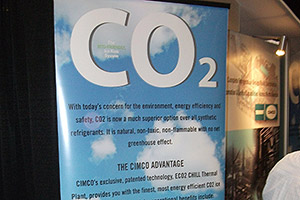EDITOR’S NOTE: This information was prepared by Hillphoenix for those involved in decisions related to installing a commercial refrigeration system utilizing CO2 as the refrigerant.

|
| Just as manufacturers like Hill Phoenix are promoting use of CO2 as a refrigerant, so too is an increasing number of contractors as evident in this display at a past industry trade show. |
Everyone talks about what it costs a supermarket to switch to a 100 percent CO2 commercial refrigeration system. And it’s true that valves, steel piping, compressors, and electronic controls can be more expensive with a CO2 booster system than with a traditional direct expansion system.
But start thinking about the costs that come next — on everything from electricity to regulatory compliance — and the return on investment on CO2 begins to make a great deal of sense.
Here are some points to consider.
• Reduced refrigerant costs. From day one, your supermarket will save money on refrigerant charge, as CO2 costs less per pound than HFCs.
• Lower system installation costs. The CO2 design requires smaller copper pipe sizes, which lowers your material costs. Expect savings of 12 to 18 percent on installation.
• Less expensive electrical installation. Every CO2 case or walk-in uses a case controller and all of the case’s internal wiring — for lights, anti-sweats, fans, defrosters, and sensors — are factory-wired to operate from it. That means a single-point electrical connection is all that’s needed. So, you can eliminate the cost of additional wiring and control boxes from your design and installation budget.
• Savings on system maintenance and performance. The case controllers and electronic expansion valves in a CO2 system control case temperature and superheat automatically. You will get optimal evaporator performance and energy use at all times.
• Savings on energy. In most cases, CO2 boosters can be more efficient than traditional commercial refrigeration systems; this is especially true in cooler climates.
• Savings on preventive maintenance. CO2 systems are equipped with electronic diagnostic monitors that alert you to a problem. If you do not have a refrigerant leak, it will cost less to recharge as the price of CO2 is less than HFCs. Plus, CO2 leaks create fewer harmful emissions.
• Improved inventory quality. The case controller that’s standard to CO2 systems helps regulate temperature better than a traditional system, improving the shelf life of foods stocked in refrigerated cases.
• Greater impact on corporate and social responsibility. Supermarkets operate more sustainably.
All of this was based on a real-world example in which a supermarket saw immediate benefits from installing a CO2 booster system. The retailer achieved lower construction and operating costs at start-up compared to what it would have cost to install a traditional direct expansion system.


Report Abusive Comment